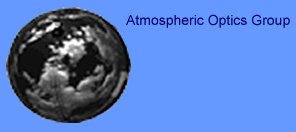
 |
| |
|
|
|
|
|
|
|
Angular CalibrationIn order to assign a position in space to each pixel, a geometric or angular calibration is required. The attached plot shows the calibration results for zenith angle, with three lenses that have been used in different versions of our instruments. A number of lens characteristics have been tested, and it was determined that a simple mapping from object space to image space could be determined by measurements of objects at known angles with respect to the lens normal. When the WSI system is focused for infinite distance, objects in object space are in reasonable focus up to only a few inches from the lens. However, for angular purposes, the nodal point, or effective front surface of the lens differs for normal angles and near-horizon angles by about 18 mm. As a result, it is necessary to place angle markers at a fairly significant distance from the lens. Markers were placed on the walls of a room, with approximately 0.1° accuracy with respect to a plumb bob location. Images are acquired in this room with the full system facing the 0 degree marker. The system is mounted on a rotary table, so that additional measurements can be taken at known orientations to provide redundancy in the measurements. The resulting pixel-position-to-angle calibration is accurate to approximately 2 pixels.
Figure 1. The largest source of uncertainty in the angular orientation is normally the leveling and north alignment of the instrument, which are within approximately 1 degree if installed by experienced teams. For this reason, the solar occultor was fabricated with a 4-log neutral density that enabled detecting the solar disk in the image. In certain applications, particularly with the original Day system EO5, the path of the sun on the image was compared with the computed path of the sun. This enables one to determine the level and orientation errors, and make corrections accordingly. A higher level of accuracy was desired for the Day/Night WSI, and the final calibration is based on images of the star field. This technique was developed by our colleagues in the ARM Program (Tim Tooman, personal communication), and has been further modified by MPL for other applications. In these applications, a bright star catalog is used, and the approximate location of these stars in image space is computed using the approximate geometric calibration equations and the known latitude, longitude and time. The precise locations of the center of the point spread function of the stars (with typical width 0.5 pixels) is mathematically compared with the predicted locations in the image and used to develop the precision geometric calibration equations, which are typically accurate to approximately .25 pixel.
Produced
by the Marine Physical Laboratory, SIO.
|